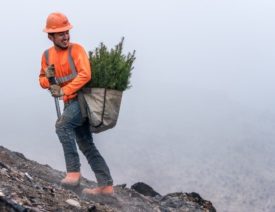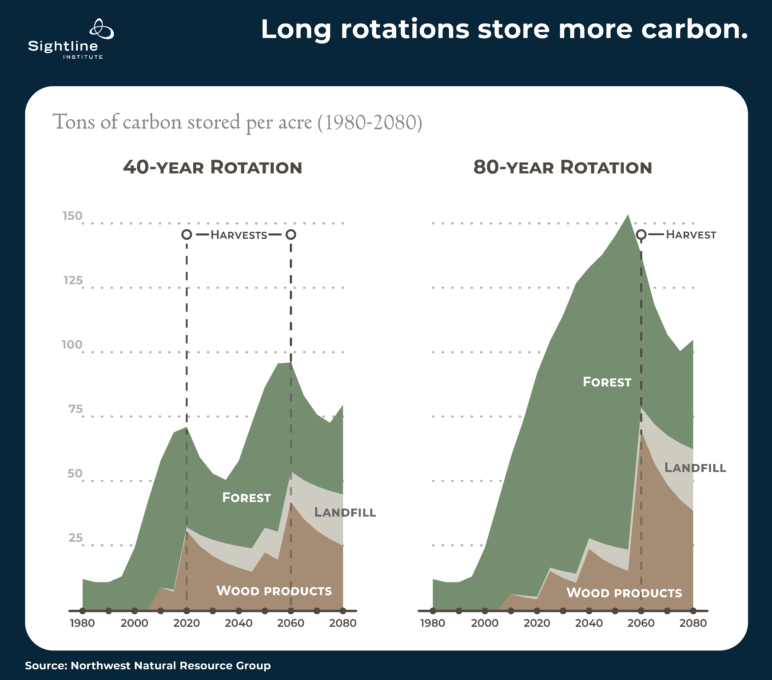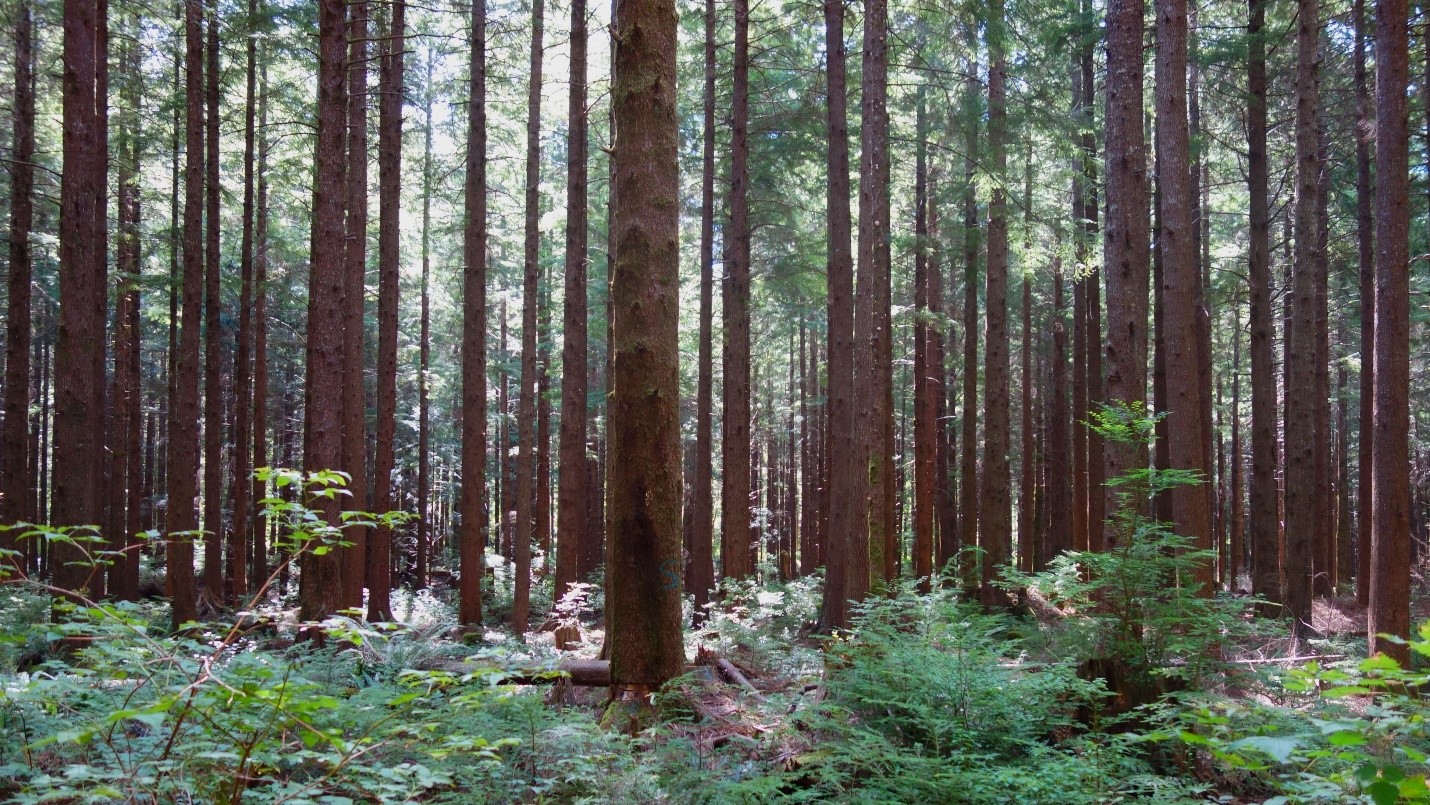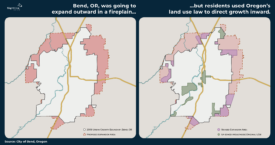Forest owners want to know: Will extending my forest harvest rotation produce real climate gains? Timberland owner Richard Pine says, “I’m not entirely convinced.” And he’s not alone.
“Long rotations” refers to delaying logging1 and growing forests past a short life, letting them reach something closer to what’s sometimes called the biological growth maximum, the age that yields the greatest volume of timber from the land over time. Experts, like Court Stanley, who managed Port Blakely’s long rotations for over 30 years, estimate that the biological growth maximum for Pacific Northwest forests west of the Cascades is between 80-100 years.
Applied to football quarterbacks, short rotation forestry is like retiring Patrick Mahomes at his current age of 26 because he’s no longer improving as fast as he used to. He’s still a superb quarterback, and based on NFL averages, he’s still got 10 winning years left in him.
Long-rotation forestry could mean replacing two typical 40-year harvest cycles with one 80-year cycle.2 The long-lived moist forests of the Pacific Northwest offer some of the greatest returns for longer rotations. In NFL terms, they are the Tom Brady, Brett Favre, and Warren Moons of the world’s forests—older, wiser, and winners.
As a strategy to coax more and higher-quality timber from a forest, long rotations have been the gold standard. As a tool to fight climate change, delaying harvest was enshrined in action plans all the way back to the Kyoto protocol. Today, extending rotations is an acceptable activity for banking carbon offset credits in California’s carbon market.
As far as ecosystem modelers are concerned, extended rotations as a top climate priority for Cascadia is settled science. In California, Oregon, and Washington, extending forest harvest rotations on industrial forestlands offers the highest potential carbon gains of any natural carbon solution.3

Chanterelles harvested near Onion Peak on the northern Oregon coast. Source: EFM.
How much carbon storage are we talking about? Extending rotations from 45 to 75 years on just 40 percent of private timberland would sequester up to 5.6 million metric tons of CO2 per year by 2050 in Oregon and up to 5.2 million metric tons in Washington. These amounts equal 10 percent of Oregon’s annual emissions reduction goal for 2050 and 7 percent of Washington’s target for 2050.
For about a quarter of all forestland west of the Cascades in Oregon and Washington, extending rotations could also produce enough additional timber to pay for itself, even considering the financial costs of letting trees stand for another 35-40 years: landowners have to wait much longer to get paid for their timber.
These financial costs, often alluded to with expressions such as “opportunity costs,” “the time value of money” or “the discount rate,” are what drive down harvest age from a “biological rotation age” that maximizes timber yield to a “financial rotation age” that maximizes return on investment.
Dave Walters, Vice President of Acquisitions and Business Development at timber company Green Diamond, explained: “If you look back, forests were managed to hit the peak of biological growth. As the business became more financially motivated, peaking biological growth adjusted to be peaking financial maturity of the forest. The rotation age declined and we got to this financial rotation age.”
In future articles, I will explain these and other challenges to transitioning back to long rotations—especially for the many people whose livelihoods depend on the timber industry—and I will explore possible solutions.
Long rotations in practice: It’s already working

Debra Pine on a log loader during harvest near Centralia, WA. Source: Richard Pine.
Mason, Bruce & Girard (MB&G), one of the oldest and largest consulting forestry firms in the United States, manages several forests on long rotations. For a 12,500-acre family forest in Linn County, Oregon, for example, its goal is a rotation of 80 years or more. According to MB&G’s field data, an 80-year rotation that includes commercial thinning yields 70 percent more timber than two 40-year rotations on the same land.
Edie Dooley, the MB&G forester managing this forest, is passionate about these results. “Everyone’s proposing this 80-year rotation, but they just say, ‘wouldn’t that be cool?’ And I want to tell them, ‘Hey, we’re already doing it, and it works!’ It works because you have a really healthy forest and you’re still making revenue, and you have healthy communities.”
MB&G is not alone. The Confederated Tribes of the Grand Ronde harvest on a rotation cycle of at least 70 years in stands where they use clear-cutting and replanting.
The longer rotation stored 13 percent more carbon in wood products compared with two short rotations.

Some large timber companies harvest on long rotations too. Mike Warjone, President of US Forestry at Port Blakely told me about its minimum 60-year rotation on 45,000 acres in southwest Washington. Green Diamond, which has invested in learning about carbon offsets and supported a carbon tax in Washington, is also considering extending its rotations. According to Dave Walters, “It’s not an easy thing to model, for sure. But we are taking a swing at it and trying to figure out where it may make the most sense.”
Some doubt long rotations’ benefits

A Columbia spotted frog in Desolation Creek, central Oregon. Source: EFM.
Recently, the carbon gains of long rotations have been called into question. For example, timberland owner Richard Pine has heard that harvesting on shorter rotations might actually be better for the climate.
This misconception is rampant because representatives of the timber industry are propagating it. Even some professional foresters have been convinced. A Washington State University extension forester told me, “I’ve read some literature suggesting that it’s not necessarily any different to grow two short rotations instead of one long one. You have to think about how long that carbon is going to be stored in a product. If growing trees on an 80-year rotation produced more volume, then we’d see companies do it.”
No one questions that longer rotations sequester more carbon in living forests. What’s debated is whether shorter rotations store more carbon in timber products and reduce net emissions. Pine calls it “the ongoing debate between carbon in the forest versus carbon in products.”
A side-by-side comparison: 40- vs. 80-year rotations
So does extending forest harvest rotations produce real climate gains?
Yes, absolutely—even when considering soil carbon, the entire supply chain, carbon in timber products, and potential substitution effects.

Grading logs at Malheur Sawmill in John Day, Oregon. Source: Marcus Kauffman, Oregon Dept. of Forestry.
Richard Pine, who typically aims to harvest his trees around age 65, is already harvesting on an extended rotation that is about 20-25 years longer than typical industry practice.
Could he sequester even more carbon by extending his rotations further, say, to 80 years? Yes. Because of their location and species, at 80 years old, his forests are likely still bulking up towards their biological growth maximum, storing more carbon and producing more merchantable timber.
The Northwest Natural Resource Group (NNRG) modeled carbon sequestration and timber production for a 40-year versus 80-year rotation for a forest near Centralia, Washington, that is close to Pine’s own timber lands. It found that over 100 years, doubling the rotation age increased timber production by 52 percent and kept an average of 53 percent more carbon out of the atmosphere.
Specifically, an 80-year rotation, including commercial thinning, produced 82,000 board feet of timber per acre while a 40-year rotation produced only 54,000 in total over the course of two rotations.
For carbon, over the same 100 years, the 80-year rotation sequestered 319 tons of CO2 per acre in an average year in wood products, landfills, and forest. The 40-year rotation sequestered only 209 tons of CO2 per acre over two rotations.
To answer Pine’s question of whether short rotations store more carbon in wood products: The longer rotation stored 13 percent more carbon in wood products compared with two short rotations.
For more details and a visualization of these numbers, see Appendix 1.
Seeding doubt about long rotations

A game camera wolf siting in central Oregon. Source: EFM.
So why is there speculation that harvesting on shorter rotations might actually be better for our climate?
First, the idea of extended rotations is sometimes confused with the idea of reduced harvest, eliminating harvest, or old growth. Those are completely different ideas. Long rotation simply means growing trees longer to allow a forest to reach its biological growth maximum and produce more total timber, not less.
Second, some studies make short rotations look better through bait-and-switch. They associate short rotations with vague terms like “business as usual,” but then they substitute long rotations in their actual analysis of business-as-usual practices.
Third, misapplying a “substitution effects” argument camouflages short rotations’ larger carbon footprint. Falsely assuming that long rotations decrease wood supply4 and unrealistic assumptions about how much energy-intensive concrete and steel would make up the alleged shortage, gives the illusion that short rotations decrease emissions.
Finally, some arguments against long rotations are actually arguments against an abrupt transition from short to long rotations. Any transition to long rotations must be carefully planned, not only to support timber jobs and profits, but also to avoid indirect carbon emissions from a temporary dip in lumber supply. I will explore potential strategies to do this in a future article.
Understanding a forest’s biological growth maximum

Tree planter with a sack full of seedlings. Source: Marcus Kauffman, Oregon Dept. of Forestry.
The biological growth maximum is the harvest age that yields the greatest volume of timber from the land over successive harvests, or what foresters call “maximum sustained yield.” This “biological rotation age” aims to maximize timber yield and is typically higher than the “financial rotation age,” which aims to maximize return on investment.
To understand how extending rotations sequesters more carbon and produces more timber, it helps to think of a tree, in the words of Seth Zuckerman of NNRG, as a photosynthetic factory. As the tree matures, the factory hums along, sequestering more carbon and producing more wood each year.
The key to the biological growth maximum is not wasting the sunshine. After a clear-cut, the sun pours down its photons, but they fall on stumps and seedlings. There are hardly any tree leaves or needles to photosynthesize sunlight and carbon into wood and oxygen. As a result, the photons are wasted, and the land’s capacity to grow timber and store carbon is squandered.
In round numbers, it takes at least ten years for a replanted clear-cut to green up and begin to look like a forest again. A 40-year rotation, driven more by a financial rotation age, means that 25 percent of the rotation is spent in the factory rebuilding stage, with timber production and carbon storage on hold.
If you double a short rotation, you can cut half as much forestland and produce the same amount of timber.

The biological rotation age, in contrast, accounts for this green-up period. Even though a tree’s annual growth rate peaks during adolescence, growth still remains strong long after this peak. Because of the first ten years of snail-paced growth, a tree’s average annual growth continues to increase well past its age of peak annual growth. To reach the age that maximizes sustained timber yield over time, you wait until this average annual growth rate plateaus. (Foresters call this biological maximum the “culmination of mean annual increment” or CMAI.)
For each year that passes between a young financial rotation age and the biological rotation age, we’re better capturing the land’s ability to produce wood and store carbon.
For more explanation and a visualization of why longer rotations yield more timber, see Appendix 2.
Long rotations also benefit water retention, soil health, and more

A salmon swims upstream to spawn. Source: Marcus Kauffman, Oregon Dept. of Forestry.
Carbon storage is just one of the myriad benefits from long rotations.
Back in the 1980s and 1990s, when conservationists began trumpeting long rotations, it was not for the carbon benefits but for all of the other forest ecosystem functions, from water retention to soil fertility. At a time when clear-cuts had taken center stage in the US conscience, long rotations were proposed as a way to avoid conflicts between timber communities and environmentalists.
If you double a short rotation, you can cut half as much forestland and produce the same amount of timber. And while those trees are growing to a ripe middle age of 80, for example, the long-rotation forests are better habitat for creatures like the Olive-sided Flycatcher and the red tree vole and a host of plants that can’t thrive on short-rotation plantations. There will still be plenty of younger, more open forests for species that prefer it.
MB&G forester, Edie Dooley, who manages her client’s forestlands on an 80-year rotation, sees this up close. “When you harvest half as often, you get less soil disturbance. If you choose to use herbicides and kill everything that first year, with longer rotations you do that half as much, so you have a more intact understory and a better microbial community. When I’m in that forest, I just see a huge diversity of mushrooms, and I don’t see that on the short-rotation forests next door. Bigger trees make bigger root systems, your ‘leave trees’ are bigger, your snags are bigger, your down material is bigger.”
Forestry’s future: Getting from short to long rotations
Given all the rewards of extended rotations, why don’t more timberland owners adopt the practice?
A litany of challenges bedevils long-rotation forestry. For Richard Pine, a major hurdle is the absence of a mill within economic trucking distance that can process the larger logs that longer rotations produce. Mike Warjone has endured a contraction in Port Blakely’s large log market. Edie Dooley worries about potential community impacts from reduced employment during a transition period to longer rotations.
In my next articles, I’ll lay out some of the key challenges for transitioning the landscape to long rotations, and some potential solutions.
For now, it’s clear that harvesting at a forest’s biological growth maximum is a core tenet of carbon-informed forestry. Logging at the biological maximum is how to lock up the most carbon in wood products (in addition to living forests) and is the point at which land owners get the most timber per year per acre.
Yes, long rotations can yield real climate gains for Cascadia… and healthier forests, too.

Richard, Debra, and Kerry Pine after a long day in the woods. Source: Debra Pine.
Appendix 1: A closer look at the carbon numbers
The model: To model carbon sequestration for a 40-year versus 80-year rotation in southwest Washington, NNRG used the Forest Vegetation Simulator and conservatively calibrated this model to avoid overpredicting growth in older forests.5
Management: Both rotations are pre-commercially thinned at 10 years and commercially thinned at 30 years. (Thinning yields merchantable timber while making room for the remaining trees to grow more vigorously.) The 40-year rotation is then harvested and replanted at 40 years. The 80-year rotation is commercially thinned at 45 and 60 years, and harvested and replanted at 80 years.
Results: Over 100 years, if you add the total amount of carbon stored in the wood products, landfill, and standing forest, each acre in the 80-year rotation stores 87 tons of carbon (sequestering 319 tons of CO2) in an average year, ranging from 11 tons of carbon stored in a year during the early days of forest growth to 154 tons just before harvest. On a 40-year rotation, the same acre of forest sequesters only 57 tons of carbon (209 tons of CO2) in an average year, ranging, over the 100 years, from 11 to 96 tons.
Specifically, the 80-year rotation stores an annual average of 18 tons of carbon in timber products, 6 tons of carbon in landfills (after the wood products have been used and discarded), and 63 tons of carbon in the forest. The 40-year rotation stores 16 tons of carbon in timber products, 7 tons of carbon in landfills, and 34 tons of carbon in the forest (over two-plus rotations).

Carbon storage from a southwest Washington Douglas-fir forest. Source: Northwest Natural Resource Group
The figure above illustrates these results. The two graphs indicate where carbon is stored, each year, over the course of a century in a 40-year and an 80-year rotation for a Douglas-fir forest in southwest Washington.
Each color indicates a specific carbon storage category. The green area tracks carbon in the forest (above- and below-ground). The brown tracks the carbon stored in wood products. And the gray tracks carbon stored in landfills.
The silhouette of the green area shows the total carbon added together from wood products, landfills, and forest. The locations where the brown area spikes up—for example, in 2060 on both graphs—indicate when the forest is harvested or commercially thinned. At the harvest years, the silhouette shrinks, even though trees are converted to wood products that store carbon, because the branches and tree tops are burned or start to decay. Over the next few years, the silhouette continues to decline as a portion of the carbon stored in wood products returns to the atmosphere.
These graphs show that growing forests closer to their biological growth maximum not only stores more carbon in the living forest, but also in the timber products this forest produces.
Appendix 2: A closer look at the biological growth maximum
The figure below illustrates annual growth and average annual growth for a Douglas-fir forest west of the Cascades. This forest’s biological growth maximum occurs around 80 years.
The “annual growth rate” curve (called the “periodic annual increment,” or PAI, in forestry jargon) peaks during the forest’s adolescence, around age 40. However, the forest continues growing steadily long after this peak.
Because it takes at least ten years for a replanted clear-cut to green up and begin vigorously producing wood, a tree’s “average annual growth rate” (called the “mean annual increment,” or MAI, in forestry jargon) continues to increase, even past its age of maximum annual growth. That is, the tree’s total growth divided by its age is still increasing. To reach the biological maximum, you wait until this average annual growth plateaus. (Foresters call this biological maximum the “culmination of mean annual increment,” or CMAI.)
The figure shows that the average annual forest growth continues to increase well past a financial rotation age when forest owners log to maximize profits.

Every forest has a different biological maximum age, depending on tree species, water availability, temperature, soil nutrients, sunlight, and silvicultural management. A lodgepole pine forest in eastern Washington would grow more slowly than the forest illustrated above, and its biological maximum would be older. A loblolly pine forest in the southeastern United States would grow more quickly, with a younger biological maximum.
Managing for longer rotations (for example, harvesting intermediate commercial thinning) can substantially increase the maximum sustained yield and the biological maximum, for example, from 75 to 105 years, according to one study.
One challenge in trying to agree on the carbon footprint of different rotation lengths is the uncertainty in predicting a forest’s biological maximum. Different modeling and calculation methods have always produced different results, but recent intensification of silvicultural practices (such as multi-year use of herbicide, fertilization, and genetically improved seedlings) has increased annual growth. Because these intensively managed forests are essentially never allowed to grow past a short rotation of 35-45 years, foresters can only speculate on the long-term growth potential as these trees age and the consequent rotation age that maximizes yield. What’s more, we have little data on long-rotation forests that are well managed for timber yield. The data on older forests come almost entirely from forests that were minimally managed, hindering any short-versus-long-rotation comparison due to the non-comparability of the available data.
The bottom line: Regardless of a particular forest’s growth curve, the principle of long rotation forestry remains the same. Growing a forest closer to its biological growth maximum produces more timber and stores more carbon.











Jack Sisco
Thought you would like this article by Sightline in regard to timber harvesting
Steve Erickson
Excellent article for explaining modern industrial forestry. What is left out is the rationale for the ever shorter and shorter “rotation” ages used by industry.
Cash in hand means:
1. Higher stock prices and therefore rewards for owners, executives and stockholders;
2. Money to invest in higher yielding investments. Trees grow as fast as they grow, +/- 2%/year. But catch a shooting BitCoin at the right part of its bubble . . .
3. If the land with the trees was acquired via leveraged takeover or by quick buck artists, liquidating the forest is no different than laying off workers, selling off the factory equipment, and declaring bankruptcy to avoid environmental and worker obligations. Examples: Plum Creek Timber in the 1980s-90s in Montana and the eastern Washington Cascades, or Trillium in Whatcom, Skagit, Snohomish, and Island Counties in the late 1980s – early 1990s.
In the 1970s-80s standard industry rotations west of the Cascades were 60 years. They keep getting shorter and shorter. As long as forest liquidation, even if its only toothpicks, produces movable capital that can produce a better return when invested in widgets, real estate, or anything else, we’ll continue to have our regional life support system (the forests) managed primarily for private profit (with a little window dressing for other “values”).
Meanwhile, the legislature and Hilary Franz have swallowed the industry greenwashing that wood used in modern construction results in sequestered Carbon. Look at the quality of that wood and the structures that are being built with it. A 60 year life span is optimistic.
Kate Anderson
“Shooting BitCoin,” indeed. Thank you for this comment. I hope you’ll read my second (next) article on rotations, in which I echo your points and also explain three additional “rationales” for short rotations.
asdf2
I suppose one disadvantage of long rotations not mentioned in this article is forest fires. The longer the rotation, the more consecutive years have to go by without a large fire or else the entire investment goes up in smoke.
Kjell Prytz
According to IPCC SPP1-1.9, i.e. Paris Agreement, the world needs to sequester 400 Gton co2 until year 2100. Prolonging rotation time a few decennia will not make any positive difference in reaching the climate target. The only way to reach the target is to stop logging fully.
Also wood products have a limited life time. Over a rotation time most of it will be burnt, at least in swedish forestry (my country).
Dale
> Finally, some arguments against long rotations are actually arguments against an abrupt transition from short to long rotations. Any transition to long rotations must be carefully planned, not only to support timber jobs and profits, but also to avoid indirect carbon emissions from a temporary dip in lumber supply. I will explore potential strategies to do this in a future article.
This is, in fact, the entire argument. None of the biological science here is seriously in dispute (the CMAI is, in fact, the CMAI). The question is how to get from here to there. Log supply in “Cascadia” is already seriously constrained. An extended rotation strategy will — *definitionally* — result in a further decrease in supply for some period of time. The question not whether such a strategy will take a bite out of the industry. It’s a question of how big a bite, and over what period of time. The papers I’ve seen indicate that statewide policies can, in fact, result in very serious multi-decadal declines (e.g., Latta et al., 2016). Combine that with the fact that 80 year old stands already face significant habitat and environmental pressure, and you propose a hit to the industry with a very real risk that harvest volumes will never recover. This is why the manufacturing sector struggles to get behind these strategies. The whole concept appears to be a wolf in sheep’s clothing. And when you account for the very real potential for harvest leakage — meaning the industry would take the hit for literally no environmental benefit — you begin hearing echoes of the spotted owl. Tens of thousands of jobs lost. Entire communities decimated . . . and there are fewer owls today than there were in the nineties. Fool me once.
David Moore
Great article and the carbon market link is a key to getting this done. Also acquiring vastly more public timber land would give us more control over logging.